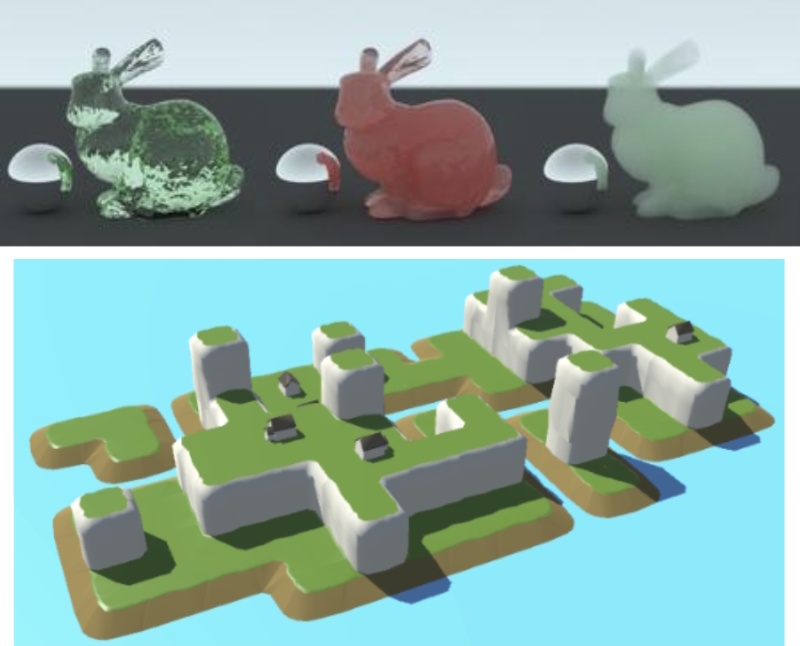- Transformations, lighting models, rendering, animation, determination of visible surfaces, procedural generation algorithms.
- Human-computer interaction methods for interactive computer graphics.
- Interactive applications developed using graphics libraries, real-time game engines and 3D modeling programs.
- Project of the student's own choice to deepen knowledge in a specific area of computer graphics and interaction.
DH2323 Computer Graphics and Interaction 6.0 credits

This is an intermediate-level course on computer graphics programming and human-computer interaction, culminating in a 3 credit project of the student's own choice that they will specify and implement using a computer graphics technology stack of their choice (programming language, libraries, game engines, etc) for human-computer interaction applications. Prior knowledge of computer graphics, for example via a course such as DH2320 Introduction to Computer Graphics and Visualization, will be very helpful, but no prior computer graphics knowledge is necessary. DH2323 is especially useful if you intend to take DH2413 Advanced Graphics and Interaction or DD2470 Advanced Topics in Visualization and Computer Graphics, or would like to use real-time interactive 3D graphics techniques in your Master thesis. Its focus on the technical use of computer game technologies pairs well with DH2650 Computer Game Design, which occurs at the same time and shares teaching staff as well as some guest lectures.
Information per course offering
Information for Spring 2026 dgi26 programme students
- Course location
KTH Campus
- Duration
- 16 Mar 2026 - 1 Jun 2026
- Periods
Spring 2026: P4 (6 hp)
- Pace of study
33%
- Application code
60226
- Form of study
Normal Daytime
- Language of instruction
English
- Course memo
- Course memo is not published
- Number of places
Places are not limited
- Target group
- Searchable for students from year 3 and for students admitted to a master's programme as long as it can be included in your programme.
- Planned modular schedule
- [object Object]
- Schedule
- Schedule is not published
- Part of programme
Contact
Course syllabus as PDF
Please note: all information from the Course syllabus is available on this page in an accessible format.
Course syllabus DH2323 (Spring 2026–)Content and learning outcomes
Course contents
Intended learning outcomes
After passing the course, students should be able to
- explain and program important algorithms for computer graphics, such as transformations, lighting models and rendering techniques
- select, motivate, and use an appropriate programming language (eg, C++, Javascript, Python, Rust), graphics library (eg, Vulkan, OpenGL), game engine (eg, Unity3D, Godot, or Unreal), and/or a modeling application (eg, Blender or Maya) to create 3D objects, environments, and visualizations
- develop a specification for a problem or design in computer graphics and interaction, and then build a solution and visualize the results
in order to be able to select, program and use software platforms to create sophisticated modern computer graphics applications.
Literature and preparations
Specific prerequisites
Knowledge and skills in programming, 6 credits, equivalent to completed course DD1337/DD1310-DD1319/DD1321/DD1331/DD1333/DD100N/ID1018/ID1022.
Recommended prerequisites
DD1320 Applied Computer Science or corresponding and DH2320 Introduction to Visualization and Computer Graphics
Literature
Examination and completion
Grading scale
Examination
- LABA - Laboratory work, 3.0 credits, grading scale: P, F
- PROA - Project, 3.0 credits, grading scale: A, B, C, D, E, FX, F
Based on recommendation from KTH’s coordinator for disabilities, the examiner will decide how to adapt an examination for students with documented disability.
The examiner may apply another examination format when re-examining individual students.
If the course is discontinued, students may request to be examined during the following two academic years.
Examiner
Ethical approach
- All members of a group are responsible for the group's work.
- In any assessment, every student shall honestly disclose any help received and sources used.
- In an oral assessment, every student shall be able to present and answer questions about the entire assignment and solution.
Further information
Course room in Canvas
Offered by
Main field of study
Education cycle
Supplementary information
You can only count one of the courses DH2323 Computer Graphics and Interaction and DH2640 Graphics and Interaction Programming in your degree.
In this course, the EECS code of honor applies, see:
http://www.kth.se/en/eecs/utbildning/hederskodex